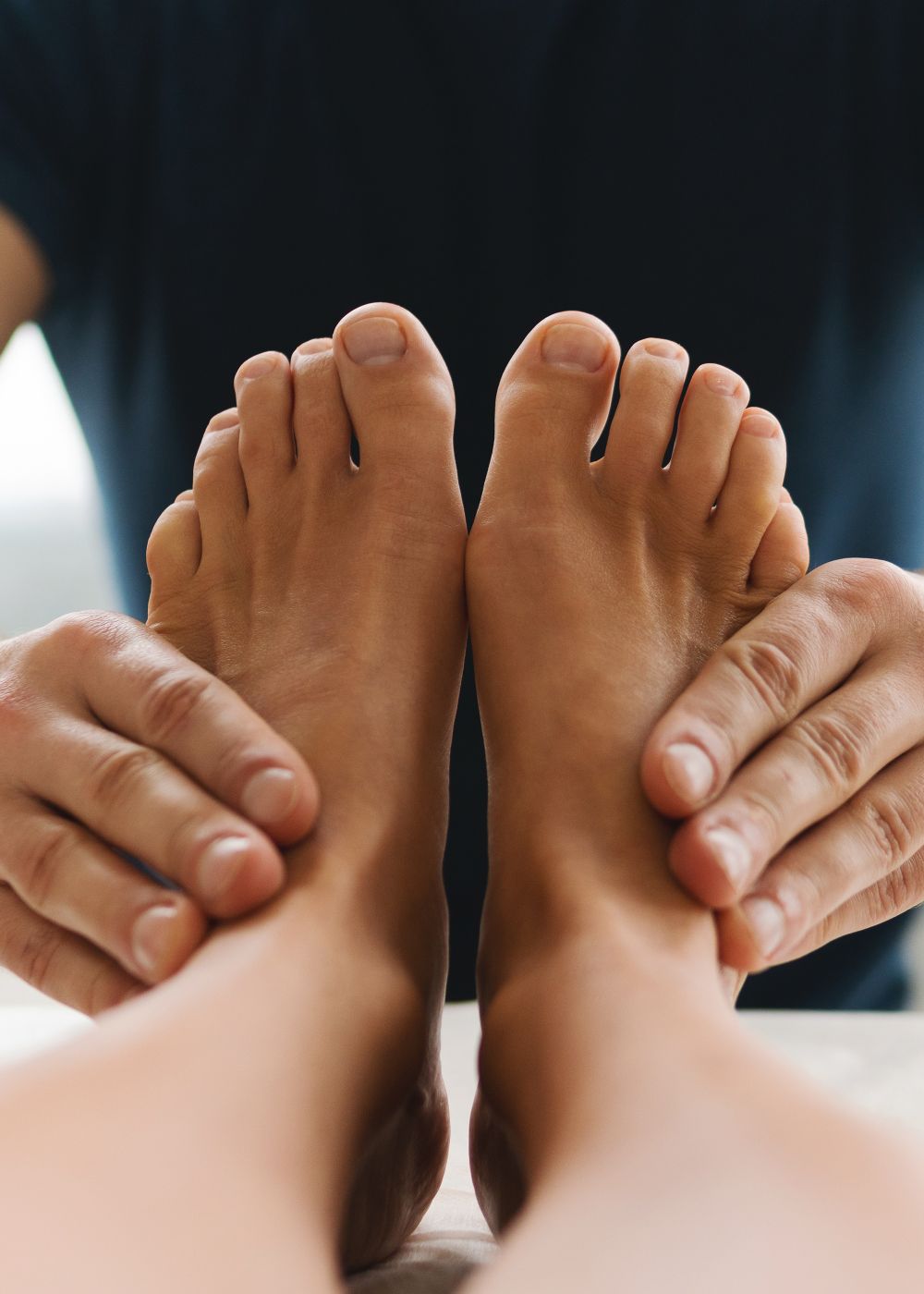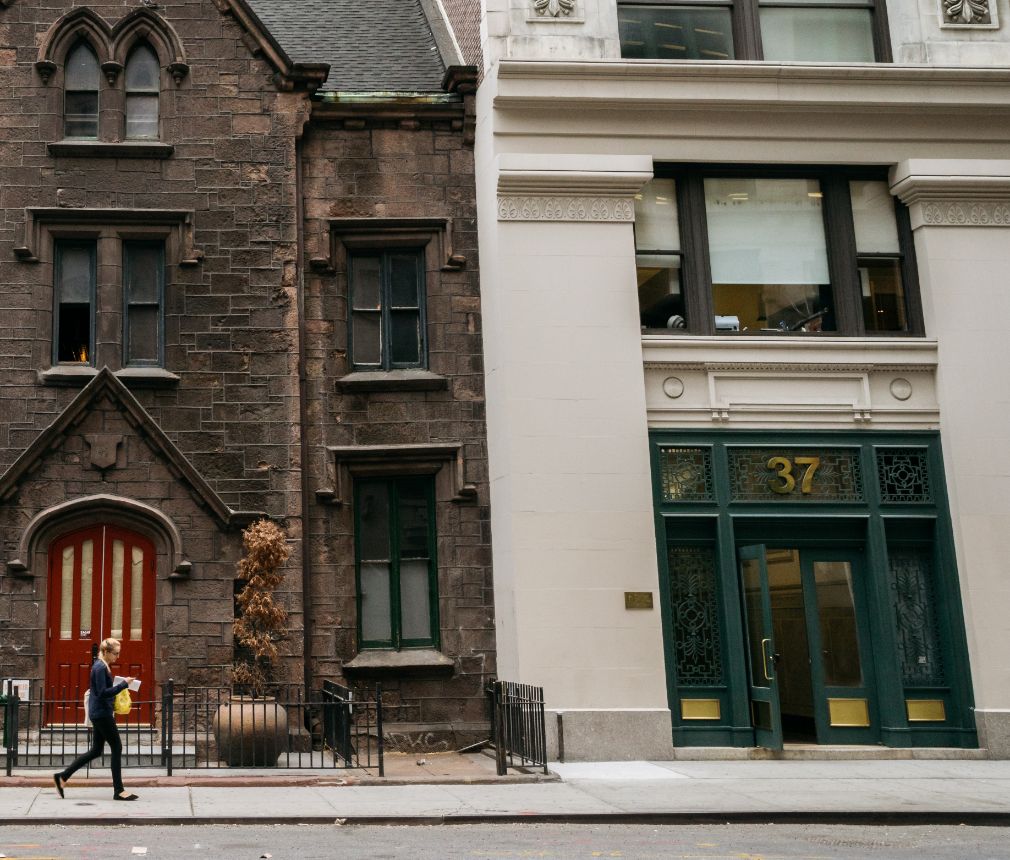Treatment for
Tailor’s Bunion
in New York, NY
Tailor’s Bunion
A Tailor’s bunion forms on the opposite side, next to the little toe. While this type of bunion is less common than regular bunions, they can cause significant pain, especially when wearing certain types of shoes.
Tailor’s Bunion

What Causes Tailor’s Bunions?
A Tailor’s bunion, or “bunionette,” occurs when the 5th metatarsal bone (the bone just behind the little toe where the toe meets the foot) moves outward or becomes enlarged. This can be caused by:
- Poorly fitting footwear like narrow or high-heeled shoes
- Loose ligaments in the foot
- Tight calf muscles
- An intrinsic muscle imbalance
- Ligamentous laxity and other collagen vascular disorders
- The little toe or fifth metatarsal bone is abnormally positioned
- Other structural problems in the foot
Chelsea Foot and Ankle in New York City provides effective surgical and non-surgical options to treat all Tailor’s bunions types to restore full foot function.
How Do I Know if I Have a Tailor’s Bunion?
Look for these signs or symptoms to evaluate your condition at home:
- Do you have a small bump near the outside of your little toe?
- Has it grown larger over time?
- Does it cause pain and redness that increases when wearing shoes?
Tailor’s bunions can form on just one or on both feet.
A consultation with Dr. Ethan Ciment is the best way to obtain a precise diagnosis.
Our doctor(s) will listen carefully to your concerns, then perform an examination to determine the cause of your pain and the overall condition of your feet.
Your treatment plan will be fully customized and include the appropriate diagnostic imaging and procedure(s) for your condition.
Why Choose Chelsea Foot and Ankle To Treat Your Tailor’s Bunion?
Our team considers every patient as part of the family, and you can expect to be treated like the VIP you are. We respect you, your time, and your wallet by offering comprehensive services at reasonable prices customized to meet your unique needs.
What Are Your Non-Surgical Tailor’s Bunion Treatment Options?
While Tailor’s bunion removal requires surgery, the following non-surgical approaches might be advised if the bunion is small and not yet causing significant discomfort.
- Wear comfortable, flexible shoes with plenty of room for your toes to move. Shoes with extra width in the forefoot are ideal for this condition.
- Avoid high heels and pointed or narrow shoes.
- Place a bunion pad over the bunionette to prevent it from pressing against your shoe.
- Place ice against the area three times per day for 5 to 10 minutes.
- Practice calf stretches in the morning and evening. Face a wall with your toes pointing forward, then use the affected leg to take a step back and stretch the calf. Hold this position for 30 to 60 seconds.
- Use an over-the-counter pain reliever containing ibuprofen, such as Advil® and Motrin®, or another nonsteroidal anti-inflammatory drug (NSAID) to decrease swelling and relieve pain.
Non-surgical Medical Treatment:
At Chelsea Foot and Ankle, we start with a conservative approach whenever possible and have had great success treating Tailor’s bunions without having to resort to invasive surgery for mild to moderate cases.
When home treatments are insufficient, we may suggest these three non-surgical treatments:
- Corticosteroid injections near your fifth metatarsal bone to bring down swelling
- Custom-made shoe inserts to cushion the bunionette and relieve pain.
Chelsea Foot and Ankle can also produce custom orthotics to correct functional causes of your Tailor’s Bunion.
What if You Need Surgery for Your Tailor’s Bunion in New York City?
Removing a Tailor’s Bunion may involve surgery if the size of the bunion or associated pain prevents you from wearing even comfortable shoes.
Tailor’s bunion surgery is performed on an outpatient basis, so you don’t have to stay overnight at a hospital.
Local anesthesia and sedation are provided to manage your pain, and your surgeon will shave away the excess tissue. We might also perform a modified osteotomy in which a part of the 5th metatarsal bone is removed and the joint is realigned to allow the little toe to straighten out. The bone will be secured with a plate, screw, or steel wire, depending on the individual needs of your Tailor’s bunion
What Are the Benefits of Tailor’s Bunion Surgery in NYC?
While surgery is generally a last resort for tailor’s bunion patients, if it’s necessary, it can provide some fantastic results, including:
- It alleviates pain. While conservative treatment can prevent, reduce, and minimize bunion pain, surgery is usually the best way to alleviate the pain altogether for long-term relief.
- Surgery is a more efficient method. Other methods can take time to see an improvement, if any. Surgery is a more reliable method of remedying the problem and has a very high success rate.
- Reduced pain results in improved mood, comfort, and physical wellness. If you live with foot pain, you most likely avoid exercise or events that require a lot of standing or walking. After your surgery, you will be able to live your life pain-free.
What Is Recovery From Tailor’s Bunion Surgery Like?
Wearing a surgical boot or post-op shoe will protect your foot for the first few weeks after surgery, and you should take steps to prevent your stitches from getting wet during this time. Using ice will reduce inflammation and speed healing, but be sure to keep the ice in a sealed plastic bag so it doesn’t seep into the stitches.
In the initial week 10 to 14 days after surgery, you still will only be able to bear weight on your heel, so you may need crutches or, more likely, a cane while you stand and walk. You’ll want to stay off your feet as much as possible during this time and keep your foot elevated whenever at rest.
After Tailor’s bunion removal surgery, your foot will be swollen. This should improve dramatically in the first 3 to 5 weeks from surgery and steadily resolve completely over the following months. Most of our patients are back to walking in their sneakers within 6 weeks of the surgery.
Physical therapy may be recommended to strengthen your lower leg and foot.
Tailor’s Bunion surgery recovery usually takes between 6 and 8 weeks. However, it can take up to 4 to 6 months for all swelling to subside, and it’s not uncommon for the foot to continue the healing process for up to 12 months before you will see the ultimate final appearance of your foot.
How Can You Prevent Tailor’s Bunion?
Tips to help you avoid Tailor’s bunion and the pain it causes include:
- Wearing comfortable and roomy shoes that fit properly, with extra room in the forefoot
- Avoiding shoes with high heels or a pointed toe
- Exercising your calves and feet
- Having your feet measured whenever buying new shoes to ensure they’re the correct size for your feet.
If you suspect a lump on your foot is a Tailor’s bunion, the sooner it’s evaluated, the faster treatment can be started, reducing the chances you’ll need a surgical fix.
Tailor’s Bunion FAQ
Can tailor’s bunions go away on their own?
The short answer is no. A tailor’s bunion will not go away without any type of treatment or intervention on your part. If the pain and swelling are due to soft tissue swelling–and you caught the issue soon enough–you may be able to help the bunion reduce by avoiding aggravating causes such as tight shoes. However, if the bunion is caused by bone, then there is no way to reduce it on its own or even without surgical care.
Can tailor’s bunions come back after surgery?
While rare, there is a slight possibility that a tailor’s bunion can reoccur even after surgery. This can be due to a small amount of tissue or bone that was not fully removed during the procedure, or the bunion can reappear with additional trauma to the feet. These instances are very rare, however, and a majority of tailor’s bunion surgery patients benefit from the results of their surgeries for years.
Is tailor’s bunion surgery worth it?
This really depends on your personal situation and the opinion of your podiatrist. If your tailor’s bunions are causing pain in your day-to-day, and conservative methods have not provided proper relief, then surgery can greatly improve your quality of life. Even though we can forget sometimes, our feet carry us everywhere in life, and persistent pain can be debilitating. If your tailor’s bunions are interfering with your ability to get through the day, surgery can definitely be worth it.
Your New York City Podiatrist for Tailor’s Bunion Treatment
Whether you need conservative treatment to prevent a tailor’s bunion from progressing or are suffering from large, painful Tailor’s bunions that require surgery, you can trust the doctors at Chelsea Foot and Ankle.

Are you interested In healing your Tailor’s Bunion?
If you are suffering from pain due to hammertoe in New York City, or any foot and ankle problem, call our office today at (646) 929-4149! Remember to check out our blog, where you can learn more about us!
Our Patients Love Us
I have been very impressed with Dr. Ciment, unlike most Drs he doesn’t seem in a rush to diagnose you and takes the time to hear about your injury and past injuries. He genuinely seems to care about finding the right path to recovery. Michael is also very friendly and helpful to work with. Highly recommend!
Dr. Ciment is absolutely amazing! He is very welcoming and does an incredible job assessing and explaining his prognosis. My physical therapist was also impressed with his communication to her.
